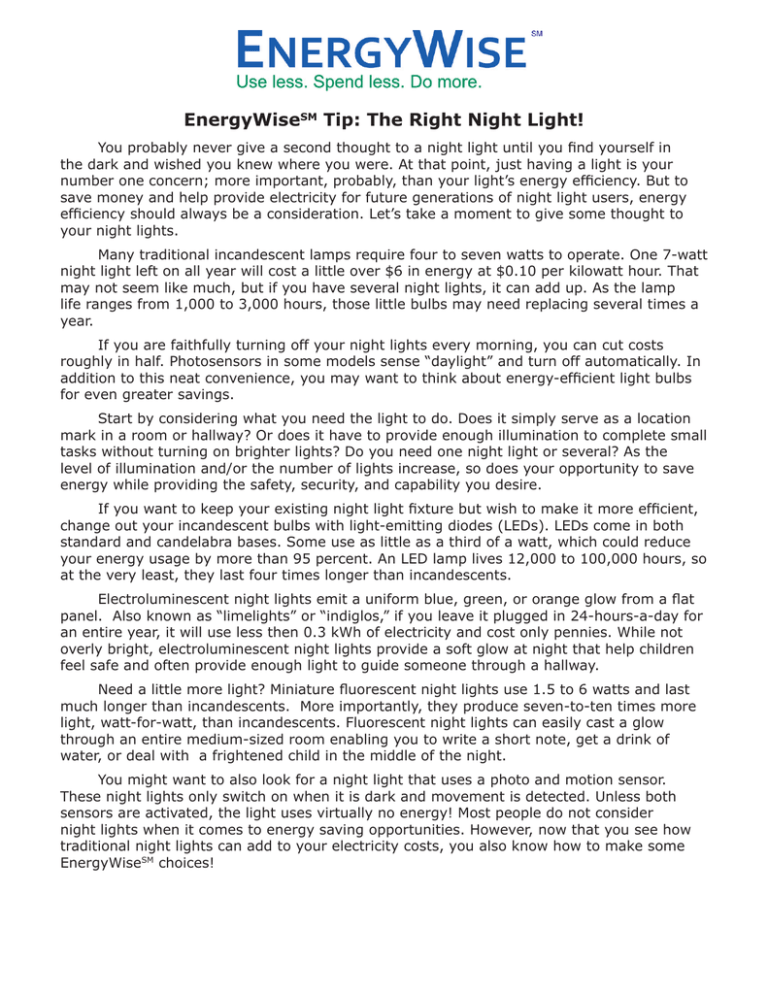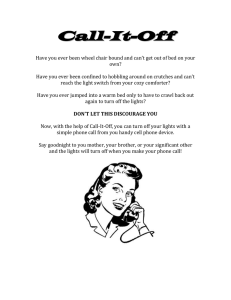EnergyWiseSM Tip: The Right Night Light!
advertisement

EnergyWiseSM Tip: The Right Night Light! You probably never give a second thought to a night light until you find yourself in the dark and wished you knew where you were. At that point, just having a light is your number one concern; more important, probably, than your light’s energy efficiency. But to save money and help provide electricity for future generations of night light users, energy efficiency should always be a consideration. Let’s take a moment to give some thought to your night lights. Many traditional incandescent lamps require four to seven watts to operate. One 7-watt night light left on all year will cost a little over $6 in energy at $0.10 per kilowatt hour. That may not seem like much, but if you have several night lights, it can add up. As the lamp life ranges from 1,000 to 3,000 hours, those little bulbs may need replacing several times a year. If you are faithfully turning off your night lights every morning, you can cut costs roughly in half. Photosensors in some models sense “daylight” and turn off automatically. In addition to this neat convenience, you may want to think about energy-efficient light bulbs for even greater savings. Start by considering what you need the light to do. Does it simply serve as a location mark in a room or hallway? Or does it have to provide enough illumination to complete small tasks without turning on brighter lights? Do you need one night light or several? As the level of illumination and/or the number of lights increase, so does your opportunity to save energy while providing the safety, security, and capability you desire. If you want to keep your existing night light fixture but wish to make it more efficient, change out your incandescent bulbs with light-emitting diodes (LEDs). LEDs come in both standard and candelabra bases. Some use as little as a third of a watt, which could reduce your energy usage by more than 95 percent. An LED lamp lives 12,000 to 100,000 hours, so at the very least, they last four times longer than incandescents. Electroluminescent night lights emit a uniform blue, green, or orange glow from a flat panel. Also known as “limelights” or “indiglos,” if you leave it plugged in 24-hours-a-day for an entire year, it will use less then 0.3 kWh of electricity and cost only pennies. While not overly bright, electroluminescent night lights provide a soft glow at night that help children feel safe and often provide enough light to guide someone through a hallway. Need a little more light? Miniature fluorescent night lights use 1.5 to 6 watts and last much longer than incandescents. More importantly, they produce seven-to-ten times more light, watt-for-watt, than incandescents. Fluorescent night lights can easily cast a glow through an entire medium-sized room enabling you to write a short note, get a drink of water, or deal with a frightened child in the middle of the night. You might want to also look for a night light that uses a photo and motion sensor. These night lights only switch on when it is dark and movement is detected. Unless both sensors are activated, the light uses virtually no energy! Most people do not consider night lights when it comes to energy saving opportunities. However, now that you see how traditional night lights can add to your electricity costs, you also know how to make some EnergyWiseSM choices!


